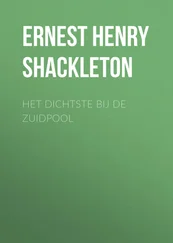Ernest Henry Shackleton - South! The Story of Shackleton's Last Expedition, 1914-1917; Includes both text and audio files
Здесь есть возможность читать онлайн «Ernest Henry Shackleton - South! The Story of Shackleton's Last Expedition, 1914-1917; Includes both text and audio files» — ознакомительный отрывок электронной книги совершенно бесплатно, а после прочтения отрывка купить полную версию. В некоторых случаях можно слушать аудио, скачать через торрент в формате fb2 и присутствует краткое содержание. Издательство: Иностранный паблик, Жанр: Путешествия и география, foreign_antique, foreign_prose, на английском языке. Описание произведения, (предисловие) а так же отзывы посетителей доступны на портале библиотеки ЛибКат.
- Название:South! The Story of Shackleton's Last Expedition, 1914-1917; Includes both text and audio files
- Автор:
- Издательство:Иностранный паблик
- Жанр:
- Год:неизвестен
- ISBN:нет данных
- Рейтинг книги:4 / 5. Голосов: 1
-
Избранное:Добавить в избранное
- Отзывы:
-
Ваша оценка:
- 80
- 1
- 2
- 3
- 4
- 5
South! The Story of Shackleton's Last Expedition, 1914-1917; Includes both text and audio files: краткое содержание, описание и аннотация
Предлагаем к чтению аннотацию, описание, краткое содержание или предисловие (зависит от того, что написал сам автор книги «South! The Story of Shackleton's Last Expedition, 1914-1917; Includes both text and audio files»). Если вы не нашли необходимую информацию о книге — напишите в комментариях, мы постараемся отыскать её.
South! The Story of Shackleton's Last Expedition, 1914-1917; Includes both text and audio files — читать онлайн ознакомительный отрывок
Ниже представлен текст книги, разбитый по страницам. Система сохранения места последней прочитанной страницы, позволяет с удобством читать онлайн бесплатно книгу «South! The Story of Shackleton's Last Expedition, 1914-1917; Includes both text and audio files», без необходимости каждый раз заново искать на чём Вы остановились. Поставьте закладку, и сможете в любой момент перейти на страницу, на которой закончили чтение.
Интервал:
Закладка:
The training of the dogs in sledge teams was making progress. The orders used by the drivers were “Mush” (Go on), “Gee” (Right), “Haw” (Left), and “Whoa” (Stop). These are the words that the Canadian drivers long ago adopted, borrowing them originally from England. There were many fights at first, until the dogs learned their positions and their duties, but as days passed drivers and teams became efficient. Each team had its leader, and efficiency depended largely on the willingness and ability of this dog to punish skulking and disobedience. We learned not to interfere unless the disciplinary measures threatened to have a fatal termination. The drivers could sit on the sledge and jog along at ease if they chose. But the prevailing minus temperatures made riding unpopular, and the men preferred usually to run or walk alongside the teams. We were still losing dogs through sickness, due to stomach and intestinal worms.
Dredging for specimens at various depths was one of the duties during these days. The dredge and several hundred fathoms of wire line made a heavy load, far beyond the unaided strength of the scientists. On the 23rd, for example, we put down a 2 ft. dredge and 650 fathoms of wire. The dredge was hove in four hours later and brought much glacial mud, several pebbles and rock fragments, three sponges, some worms, brachiapods , and foraminiferae . The mud was troublesome. It was heavy to lift, and as it froze rapidly when brought to the surface, the recovery of the specimens embedded in it was difficult. A haul made on the 26th brought a prize for the geologist in the form of a lump of sandstone weighing 75 lbs., a piece of fossiliferous limestone, a fragment of striated shale, sandstone-grit, and some pebbles. Hauling in the dredge by hand was severe work, and on the 24th we used the Girling tractor-motor, which brought in 500 fathoms of line in thirty minutes, including stops. One stop was due to water having run over the friction gear and frozen. It was a day or two later that we heard a great yell from the floe and found Clark dancing about and shouting Scottish war-cries. He had secured his first complete specimen of an Antarctic fish, apparently a new species.
Mirages were frequent. Barrier-cliffs appeared all around us on the 29th, even in places where we knew there was deep water.
“Bergs and pack are thrown up in the sky and distorted into the most fantastic shapes. They climb, trembling, upwards, spreading out into long lines at different levels, then contract and fall down, leaving nothing but an uncertain, wavering smudge which comes and goes. Presently the smudge swells and grows, taking shape until it presents the perfect inverted reflection of a berg on the horizon, the shadow hovering over the substance. More smudges appear at different points on the horizon. These spread out into long lines till they meet, and we are girdled by lines of shining snow-cliffs, laved at their bases by waters of illusion in which they appear to be faithfully reflected. So the shadows come and go silently, melting away finally as the sun declines to the west. We seem to be drifting helplessly in a strange world of unreality. It is reassuring to feel the ship beneath one’s feet and to look down at the familiar line of kennels and igloos on the solid floe.”
The floe was not so solid as it appeared. We had reminders occasionally that the greedy sea was very close, and that the floe was but a treacherous friend, which might open suddenly beneath us. Towards the end of the month I had our store of seal meat and blubber brought aboard. The depth as recorded by a sounding on the last day of March was 256 fathoms. The continuous shoaling from 606 fathoms in a drift of 39 miles N. 26° W. in thirty days was interesting. The sea shoaled as we went north, either to east or to west, and the fact suggested that the contour-lines ran east and west, roughly. Our total drift between January 19, when the ship was frozen in, and March 31, a period of seventy-one days, had been 95 miles in a N. 80° W. direction. The icebergs around us had not changed their relative positions.
The sun sank lower in the sky, the temperatures became lower, and the Endurance felt the grip of the icy hand of winter. Two north-easterly gales in the early part of April assisted to consolidate the pack. The young ice was thickening rapidly, and though leads were visible occasionally from the ship, no opening of a considerable size appeared in our neighbourhood. In the early morning of April 1 we listened again for the wireless signals from Port Stanley. The crew had lashed three 20-ft. rickers to the mast-heads in order to increase the spread of our aerials, but still we failed to hear anything. The rickers had to come down subsequently, since we found that the gear could not carry the accumulating weight of rime. Soundings proved that the sea continued to shoal as the Endurance drifted to the north-west. The depth on April 2 was 262 fathoms, with a bottom of glacial mud. Four weeks later a sounding gave 172 fathoms. The presence of grit in the bottom samples towards the end of the month suggested that we were approaching land again.
The month was not uneventful. During the night of the 3rd we heard the ice grinding to the eastward, and in the morning we saw that young ice was rafted 8 to 10 ft. high in places. This was the first murmur of the danger that was to reach menacing proportions in later months. The ice was heard grinding and creaking during the 4th and the ship vibrated slightly. The movement of the floe was sufficiently pronounced to interfere with the magnetic work. I gave orders that accumulations of snow, ice, and rubbish alongside the Endurance should be shovelled away, so that in case of pressure there would be no weight against the topsides to check the ship rising above the ice. All hands were busy with pick and shovel during the day, and moved many tons of material. Again, on the 9th, there were signs of pressure. Young ice was piled up to a height of 11 ft. astern of the ship, and the old floe was cracked in places. The movement was not serious, but I realized that it might be the beginning of trouble for the Expedition. We brought certain stores aboard and provided space on deck for the dogs in case they had to be removed from the floe at short notice. We had run a 500-fathom steel wire round the ship, snow-huts, and kennels, with a loop out to the lead ahead, where the dredge was used. This wire was supported on ice-pillars, and it served as a guide in bad weather when the view was obscured by driving snow and a man might have lost himself altogether. I had this wire cut in five places, since otherwise it might have been dragged across our section of the floe with damaging effect in the event of the ice splitting suddenly.
The dogs had been divided into six teams of nine dogs each. Wild, Crean, Macklin, McIlroy, Marston, and Hurley each had charge of a team, and were fully responsible for the exercising, training, and feeding of their own dogs. They called in one of the surgeons when an animal was sick. We were still losing some dogs through worms, and it was unfortunate that the doctors had not the proper remedies. Worm-powders were to have been provided by the expert Canadian dog-driver I had engaged before sailing for the south, and when this man did not join the Expedition the matter was overlooked. We had fifty-four dogs and eight pups early in April, but several were ailing, and the number of mature dogs was reduced to fifty by the end of the month. Our store of seal meat amounted now to about 5000 lbs., and I calculated that we had enough meat and blubber to feed the dogs for ninety days without trenching upon the sledging rations. The teams were working well, often with heavy loads. The biggest dog was Hercules, who tipped the beam at 86 lbs. Samson was 11 lbs. lighter, but he justified his name one day by starting off at a smart pace with a sledge carrying 200 lbs. of blubber and a driver.
Читать дальшеИнтервал:
Закладка:
Похожие книги на «South! The Story of Shackleton's Last Expedition, 1914-1917; Includes both text and audio files»
Представляем Вашему вниманию похожие книги на «South! The Story of Shackleton's Last Expedition, 1914-1917; Includes both text and audio files» списком для выбора. Мы отобрали схожую по названию и смыслу литературу в надежде предоставить читателям больше вариантов отыскать новые, интересные, ещё непрочитанные произведения.
Обсуждение, отзывы о книге «South! The Story of Shackleton's Last Expedition, 1914-1917; Includes both text and audio files» и просто собственные мнения читателей. Оставьте ваши комментарии, напишите, что Вы думаете о произведении, его смысле или главных героях. Укажите что конкретно понравилось, а что нет, и почему Вы так считаете.












